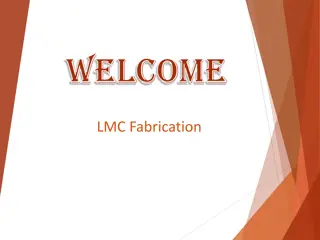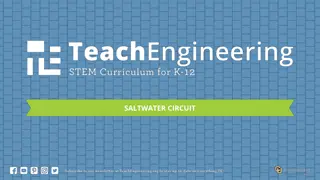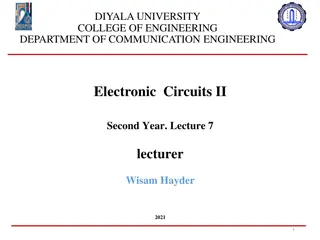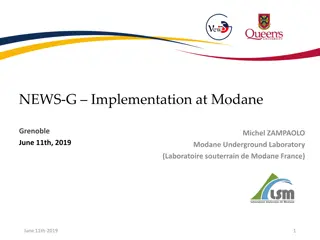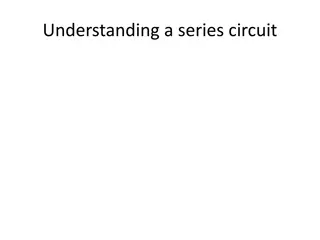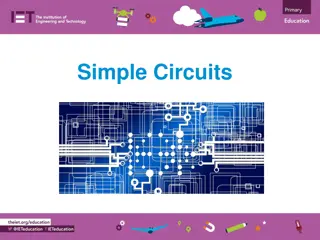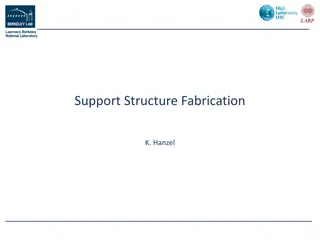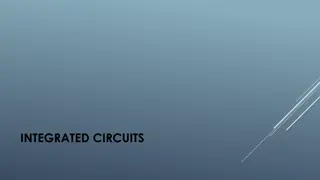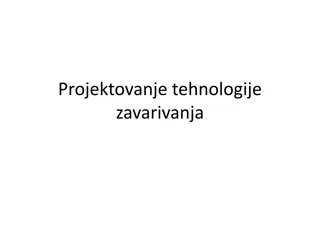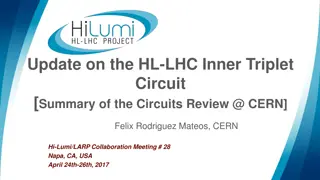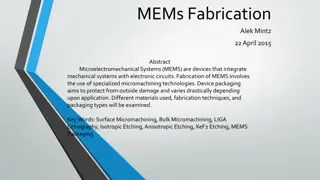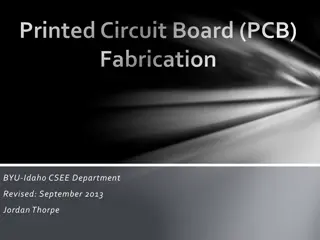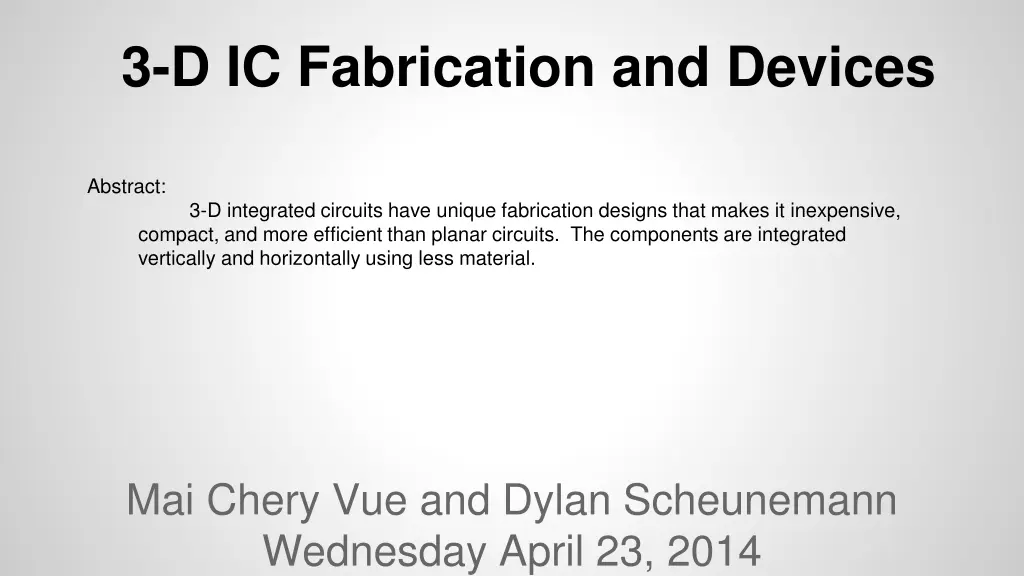
Innovative 3-D Integrated Circuits Fabrication Techniques
"Explore the world of 3-D integrated circuits and the unique fabrication designs that make them inexpensive, compact, and efficient compared to planar circuits. Learn about the various fabrication types, steps, advantages, and applications of 3-D ICs."
Uploaded on | 0 Views
Download Presentation

Please find below an Image/Link to download the presentation.
The content on the website is provided AS IS for your information and personal use only. It may not be sold, licensed, or shared on other websites without obtaining consent from the author. If you encounter any issues during the download, it is possible that the publisher has removed the file from their server.
You are allowed to download the files provided on this website for personal or commercial use, subject to the condition that they are used lawfully. All files are the property of their respective owners.
The content on the website is provided AS IS for your information and personal use only. It may not be sold, licensed, or shared on other websites without obtaining consent from the author.
E N D
Presentation Transcript
3-D IC Fabrication and Devices Abstract: 3-D integrated circuits have unique fabrication designs that makes it inexpensive, compact, and more efficient than planar circuits. The components are integrated vertically and horizontally using less material. Mai Chery Vue and Dylan Scheunemann Wednesday April 23, 2014
Outline Fabrication Types Monolithic Wafer-on-Wafer Die-on-Wafer Die-on-Die Wafer-on-Wafer Steps Advantages/Disadvantages Applications
Introduction to 3-D ICs A Single Circuit with two or more layers of active components. Components can be integrated both vertically and horizontally.
3-D IC Stacked Problem with stacking is heat dissipation.
Types of Fabrication Monolithic Built on single wafer. Diced into 3-D IC s. Wafer-on-Wafer Built on two or more wafers. Aligned, bonded, and diced into 3-D IC s. Die-On-Wafer Components built on two wafers. One wafer diced and aligned on the second wafer. Die-On-Die Components built on multiple dice. Aligned and bonded into 3-D IC s.
Types of Fabrication Chip means Die
Fabrication (Wafer-on-Wafer) Components are built on two or more wafers Alignment of wafers Machine checks for alignment mark Temporarily brought into contact Inspected for correct alignment Bonding of wafers Then bonded together using the method best suited for that wafer Such as Direct, Adhesive, or Thermocompression bonding
Fabrication (Wafer-on-Wafer) Thinning of wafers Can be thinned before or after bonding Dicing Before Grinding Saws the front before thinning from the back Dicing By Thinning Applies a trench-etching process Reduces Damage
Fabrication (Wafer-on-Wafer) Dicing of wafers Scribe and Break Mechanical Sawing Laser Cutting
Advantages Chip Performance Higher Bandwidth Reduced Power Consumption Functionality Circuit Security Device Packing Density Fits into a small space Shorter Interconnects Cheaper fabrication costs
Disadvantages Heat due to stacking Testing methods Interconnect design CAD algorithms and tools
Applications Monolithic IC 3D (Company in California) FPGA, Gate Array DRAM NAND Flash Memory Image Sensors Microdisplays
Summary 3-D integrated circuits have layered active components that are vertically and horizontally integrated. With these designs, there s about four different fabrication types: monolithic, wafer-on-wafer, die-on-wafer, and die-on-die. These new fabrication designs provide for better chip performance, circuit security, smaller interconnects, and inexpensive circuits.
References Pictures: 1. 2. 3. Information: http://esl.epfl.ch/page-42448-en.html http://lsi.epfl.ch/page-13135-en.html http://www.intechopen.com/books/metallurgy- advances-in-materials-and-processes/low- temperature-wafer-level-metal-thermo- compression-bonding-technology-for-3d- integration http://www.tezzaron.com/technology/FaStack. htm 1. http://domino.research.ibm.com/tchjr/journalindex.nsf/9fe6a820 aae67ad785256547004d8af0/2f263eb510ba6030852571c5000 32694!OpenDocument 2. http://en.wikipedia.org/wiki/Three-dimensional_integrated_circuit 3. http://homepages.rpi.edu/~luj/Papers/Luj4.pdf 4. http://www.wiley-vch.de/publish/dt/books/newTitles201201/3- 527-32646-4/?sID=p2qlnooj68su7htl8qrrc2qjt3 4. 5. http://electroiq.com/blog/2003/03/wafer-thinning-techniques-for- ultra-thin-wafers/ 6. https://www.coherent.com/Applications/index.cfm?fuseaction=F orms.page&PageID=273 7. http://www.monolithic3d.com/applications.html 8. Three-Dimensional Integrated Circuit Design by Vasilis F. Pavlidis & Eby G. Friedman
Five Key Concepts A 3-D circuit is a Single Circuit with two or more layers of active components. 4 Types of Fabrications Monolithic, Wafer-on-Wafer, Die-on-Wafer, Die-on- Die Wafer-on-Wafer Fabrication Align, Bond, Thin, Dice Disadvantage: Heat from stacking Applications: NAND Flash Memory, and Micro Displays

